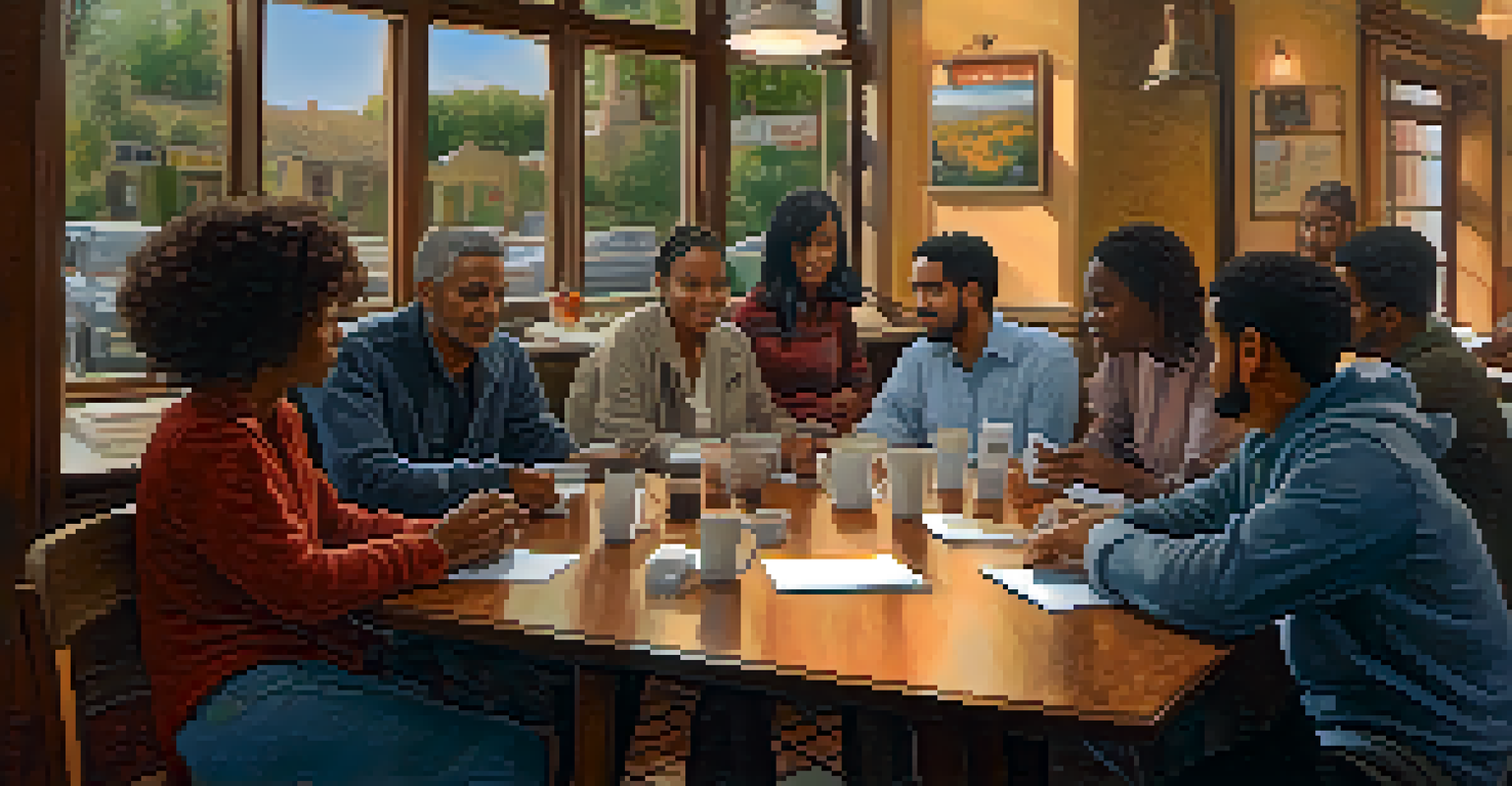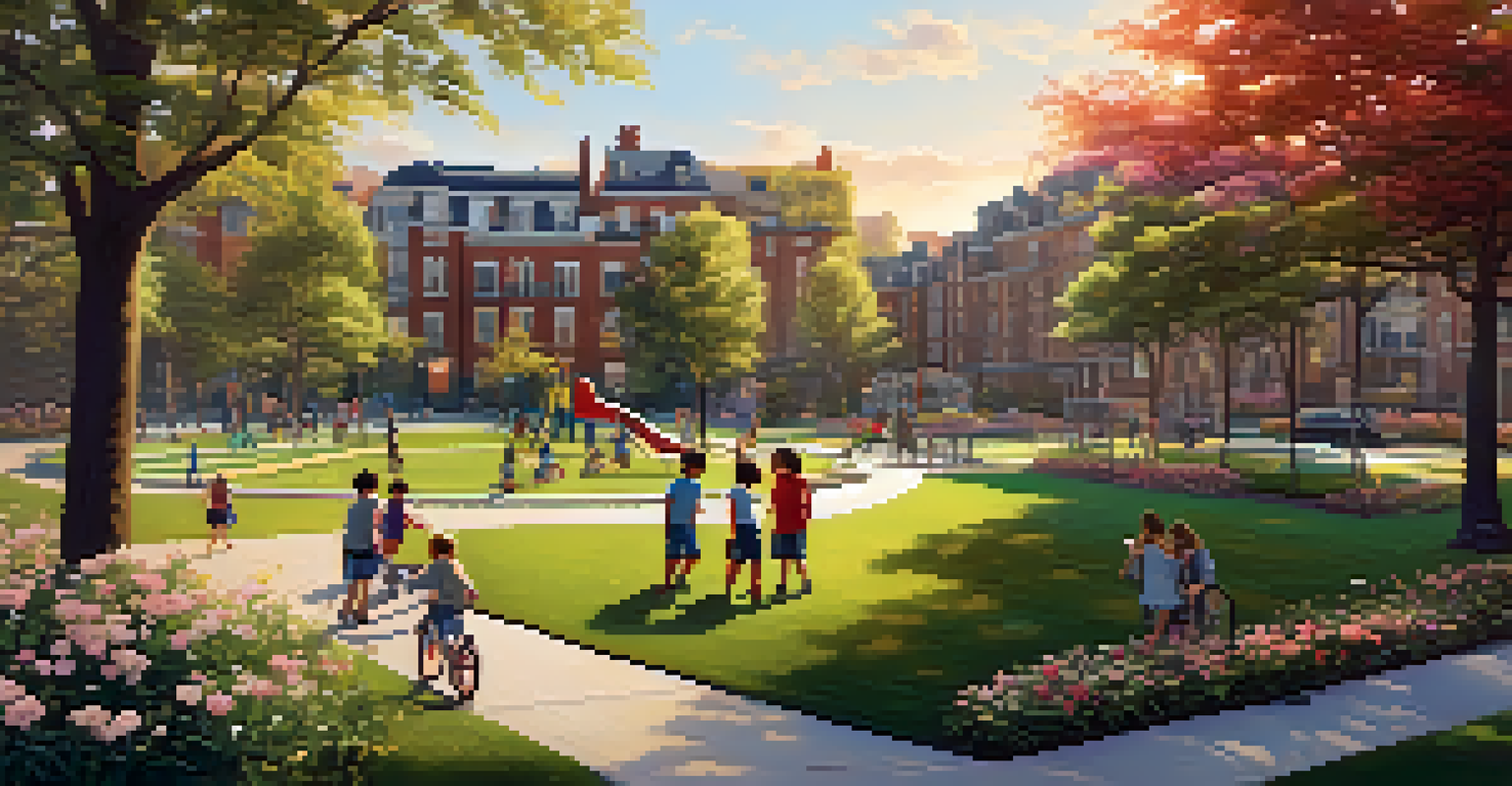The Impact of Gentrification on Neighborhood Property Values

Understanding Gentrification and Its Definitions
Gentrification is a term that describes the transformation of urban neighborhoods through an influx of more affluent residents. This process can often lead to the displacement of long-standing, lower-income residents, changing the character of the area. To put it simply, gentrification is like a double-edged sword—it can revitalize a neighborhood but also create challenges for its original inhabitants.
Gentrification is a double-edged sword; it can revitalize neighborhoods while simultaneously displacing long-term residents.
The phenomenon often results from various factors, including rising property values and the interest of developers in previously overlooked areas. Additionally, local amenities such as cafes, shops, and parks may emerge, attracting new residents. However, this can sometimes lead to tension between old and new residents, making the neighborhood feel less inclusive.
It's crucial to understand that gentrification can vary greatly from one neighborhood to another. Some areas may experience rapid changes, while others may see a more gradual transformation. Recognizing these nuances helps in understanding the broader impact on property values.
How Gentrification Affects Property Values
One of the most immediate impacts of gentrification is the increase in property values. As wealthier individuals move into an area, demand for housing rises, driving up prices. This can be great news for property owners looking to sell, but it also means that prospective buyers may struggle to afford homes in the neighborhood.

Moreover, the rise in property values often leads to increased property taxes, which can be a burden for long-term residents who may not see a corresponding increase in their income. This creates a precarious situation where some residents may be forced to leave their homes due to financial pressures. It’s a classic case of being caught between a rock and a hard place.
Gentrification Displaces Residents
Gentrification often leads to the displacement of long-standing, lower-income residents due to rising property values and rents.
In some scenarios, higher property values can lead to better public services and infrastructure improvements, such as schools and parks. However, these benefits are often overshadowed by the challenges faced by those who can no longer afford to live in their own neighborhoods.
The Role of Developers in Gentrification
Developers play a significant role in the gentrification process, often seeing potential in undervalued neighborhoods. They invest in renovations and new constructions that can enhance the area’s appeal. While this development can bring about positive changes, it can also contribute to the displacement of existing residents.
In the end, the future will depend on how communities respond to the challenges and opportunities presented by gentrification.
For example, when luxury apartments or high-end retail spaces are built, they can attract wealthier residents and businesses, pushing up the local cost of living. This means that the original community might find it increasingly difficult to remain. It’s like watching your favorite local diner get replaced by a trendy café that doesn’t quite cater to your tastes anymore.
However, not all developers are the same. Some are committed to community-oriented projects that aim to balance economic growth with social responsibility. The challenge lies in finding developers who are willing to invest in a way that benefits the entire community rather than just their bottom line.
Effects on Long-term Residents and Renters
Long-term residents often bear the brunt of gentrification. As property values rise, so do rents, which can force renters out of their homes. Imagine living in a place for years, only to find that you can no longer afford your rent due to market changes—it's a harsh reality for many.
Additionally, gentrification can create a sense of loss and displacement among longtime residents. They may feel that their community is no longer theirs, as new businesses and residents change the culture and dynamics of the neighborhood. This can lead to a sense of alienation, making people long for the days when things felt more familiar.
Developers Drive Neighborhood Change
Developers play a crucial role in gentrification by renovating undervalued neighborhoods, which can enhance the area but also push out existing residents.
Efforts to support long-term residents, such as rent control measures or community land trusts, can help mitigate some of these negative impacts. These initiatives aim to keep housing affordable and preserve the community’s character, but they require strong advocacy and support from local governments.
The Positive Aspects of Gentrification
While gentrification often has negative connotations, it can also bring positive changes to neighborhoods. For instance, increased investment can lead to improved infrastructure, such as better roads, parks, and public transportation. These upgrades can enhance the quality of life for all residents, regardless of their income level.
Moreover, the influx of new businesses can create jobs and stimulate the local economy. A neighborhood that may have previously struggled to attract investment can become a vibrant hub of activity, benefiting everyone involved. It's like sprinkling a bit of magic dust on an area that needed a revival.
However, it’s important for community leaders and residents to advocate for inclusive development that benefits everyone. By fostering a dialogue between new and existing residents, neighborhoods can thrive while preserving their unique identities.
Community Responses to Gentrification
In response to gentrification, many communities have mobilized to protect their interests. Grassroots organizations often advocate for affordable housing and policies that prioritize the needs of longtime residents. These efforts can empower residents to have a say in their neighborhood’s future, fostering a sense of ownership and pride.
For example, community meetings and forums can provide platforms for residents to voice their concerns and propose solutions. When people come together to discuss their vision for the neighborhood, it can lead to innovative ideas that bridge gaps between different groups. It’s a bit like holding a neighborhood potluck—everyone brings something to the table.
Community Advocacy Is Essential
Grassroots organizations and community initiatives can help protect long-term residents' interests and promote inclusive development amidst gentrification.
Additionally, initiatives such as community land trusts can help maintain affordability by removing land from the speculative market. This approach allows communities to have a stake in their own development, ensuring that gentrification benefits everyone rather than a select few.
The Future of Gentrification and Property Values
Looking ahead, the conversation around gentrification and property values will continue to evolve. As urban areas grow and change, it’s essential to find a balance between development and community preservation. This requires ongoing dialogue between policymakers, developers, and residents to create sustainable solutions that benefit all.
One potential avenue is the incorporation of mixed-income developments, which can help maintain diversity within neighborhoods. By integrating affordable housing with market-rate units, communities can foster a more inclusive atmosphere where everyone can thrive. It's like mixing different ingredients to create a delicious recipe.

Ultimately, the future will depend on how communities respond to the challenges and opportunities presented by gentrification. By prioritizing collaboration and inclusivity, neighborhoods can navigate these changes in a way that enhances property values while preserving their unique character.